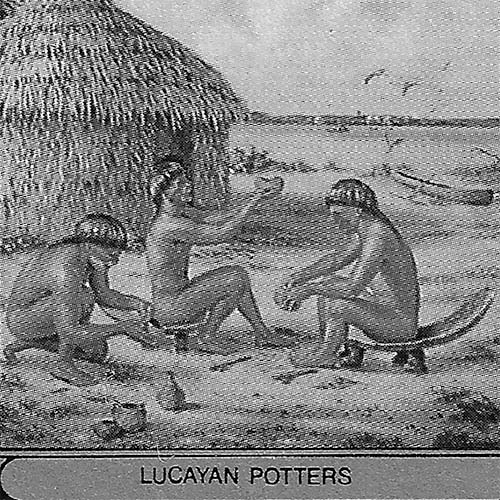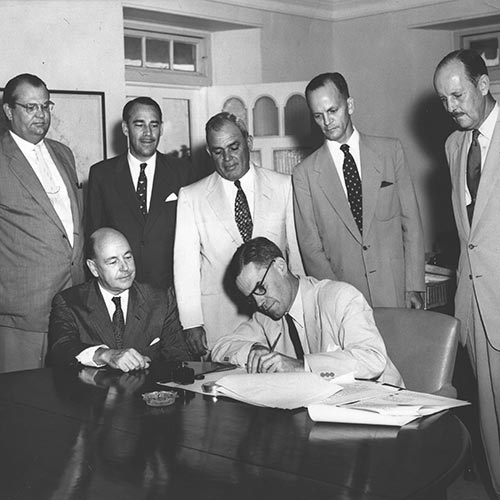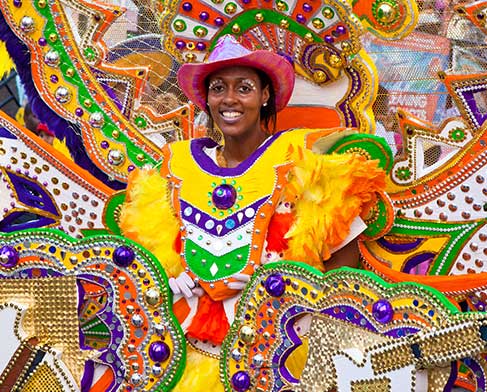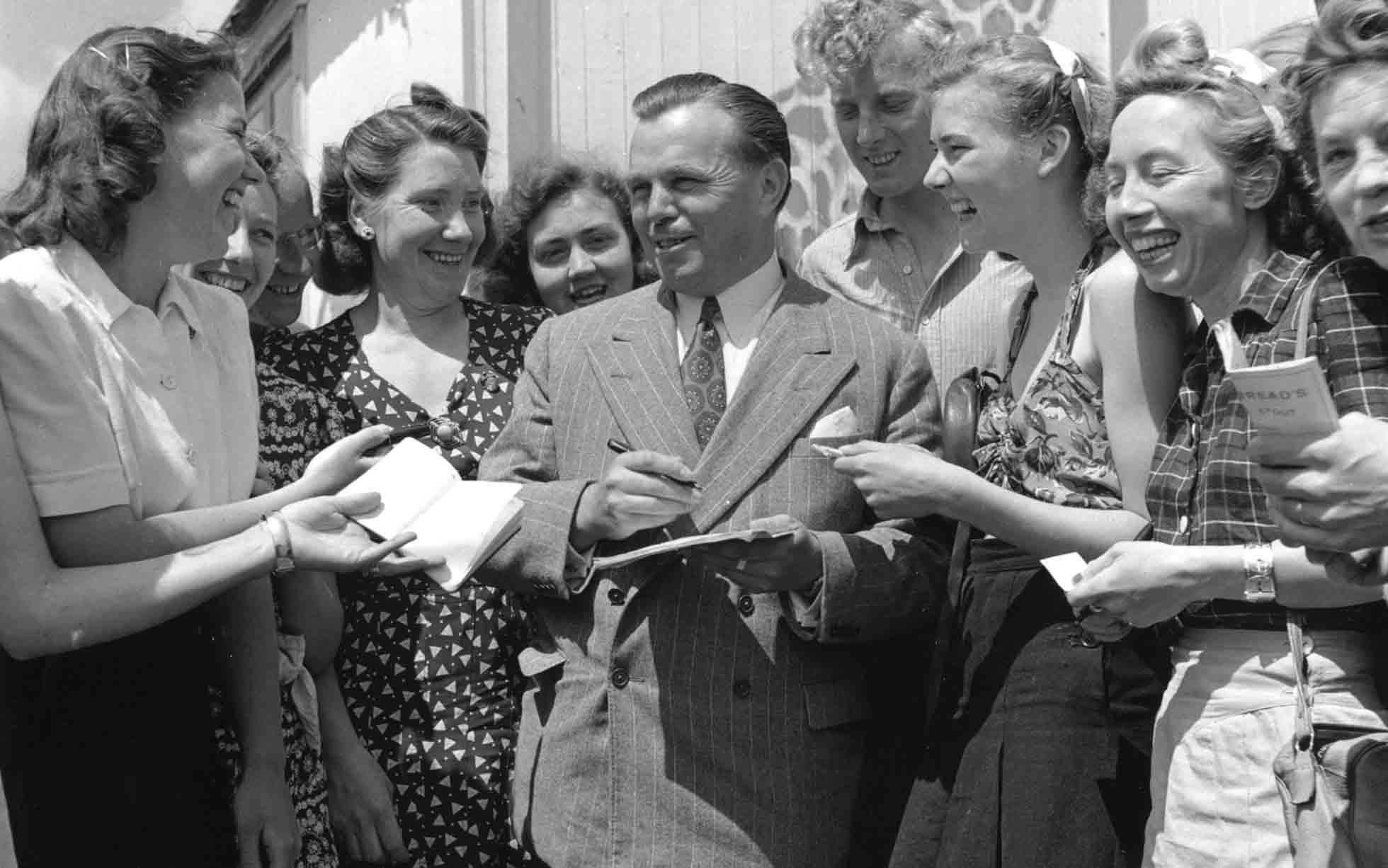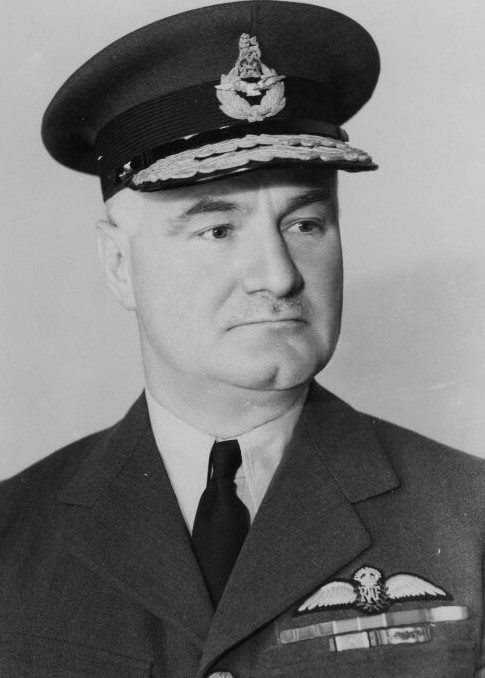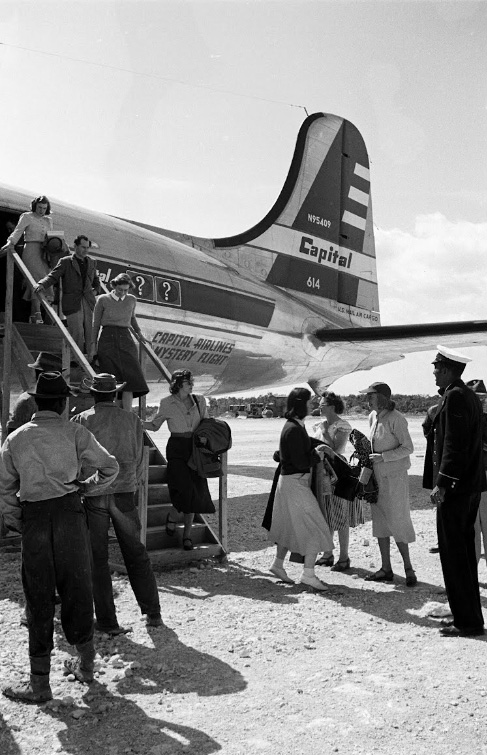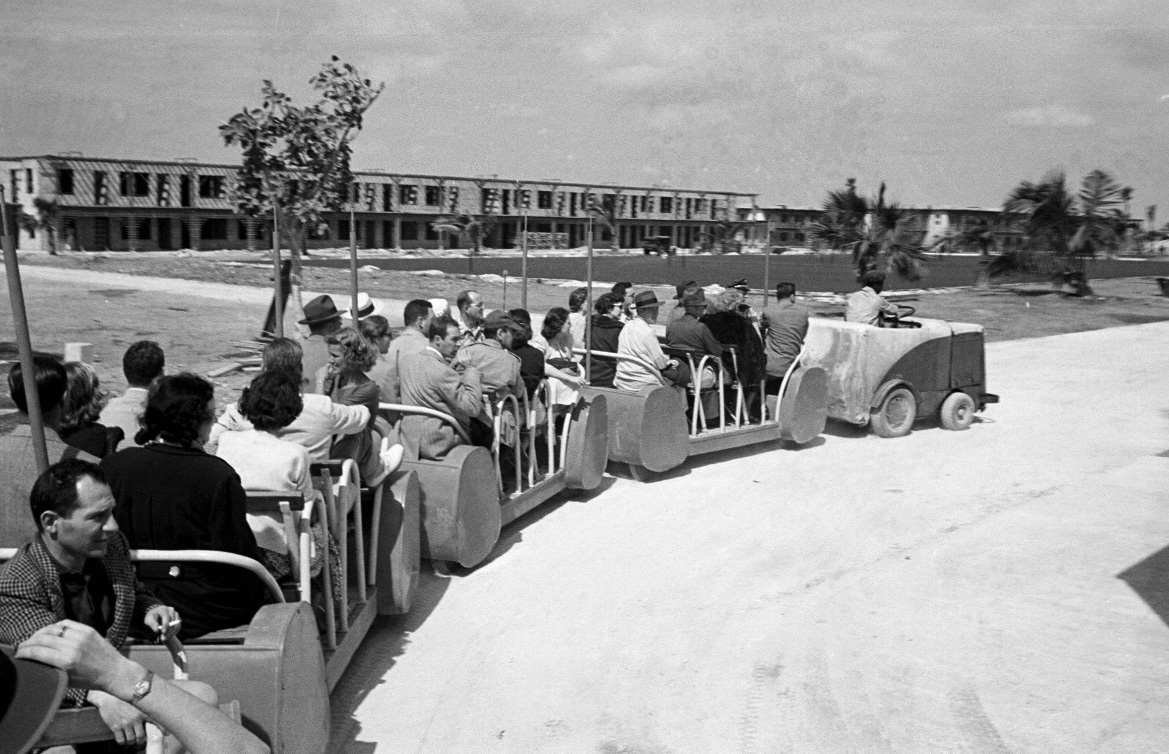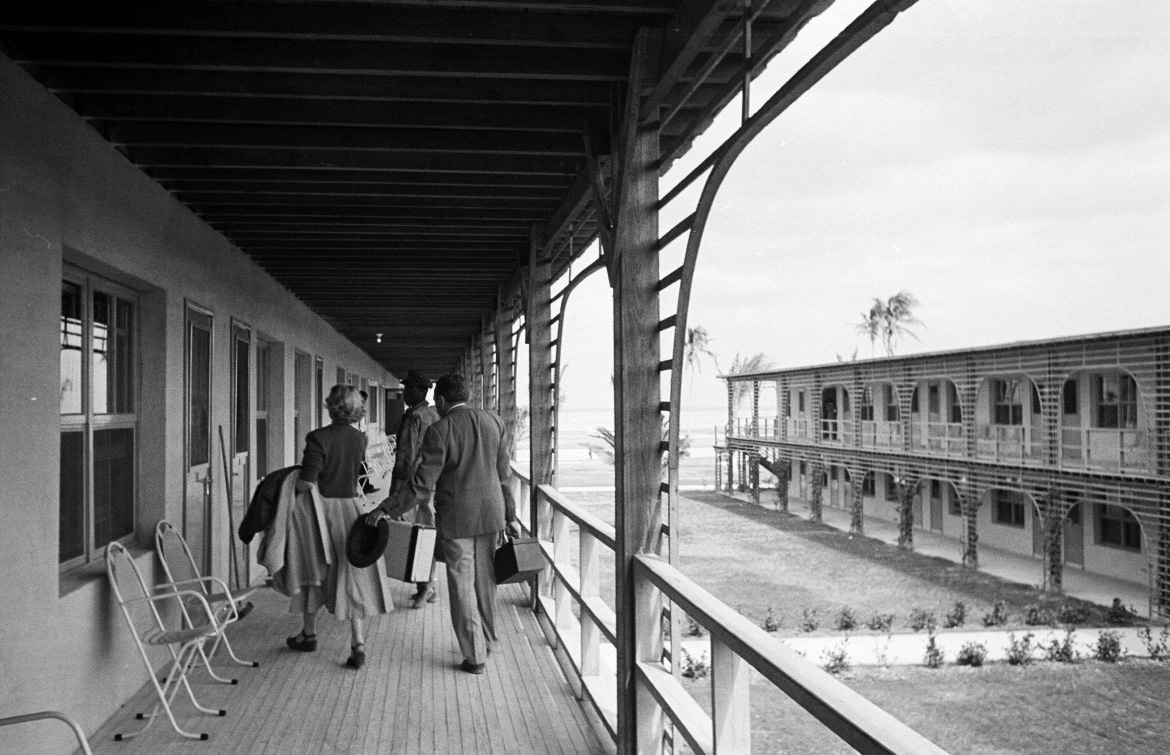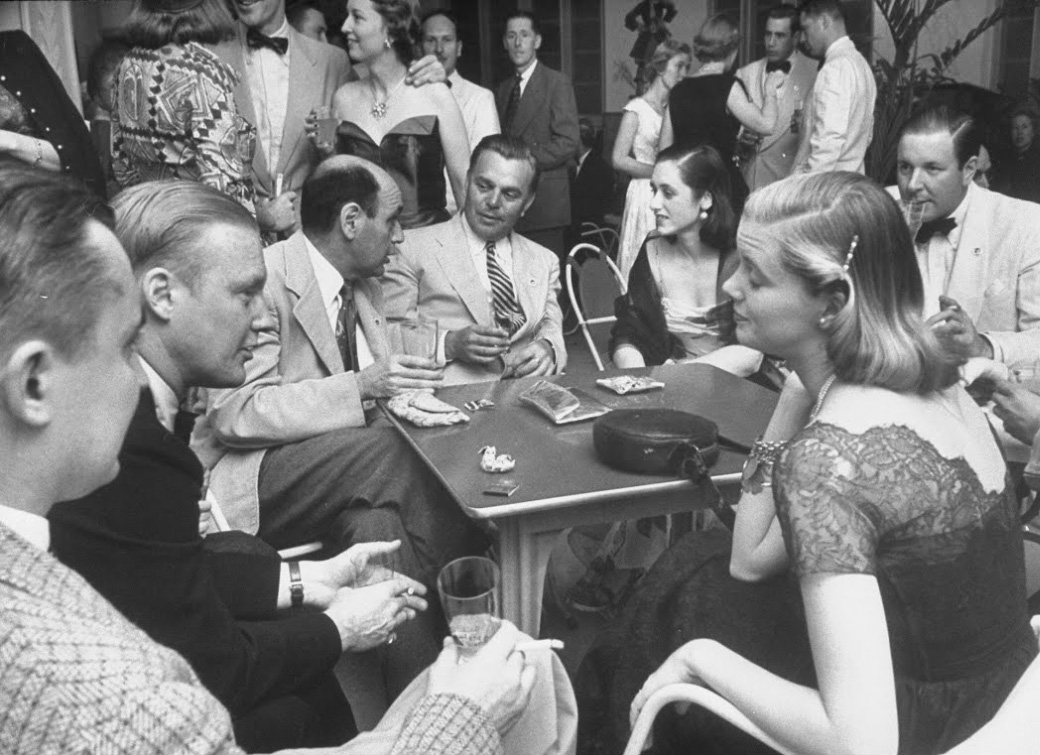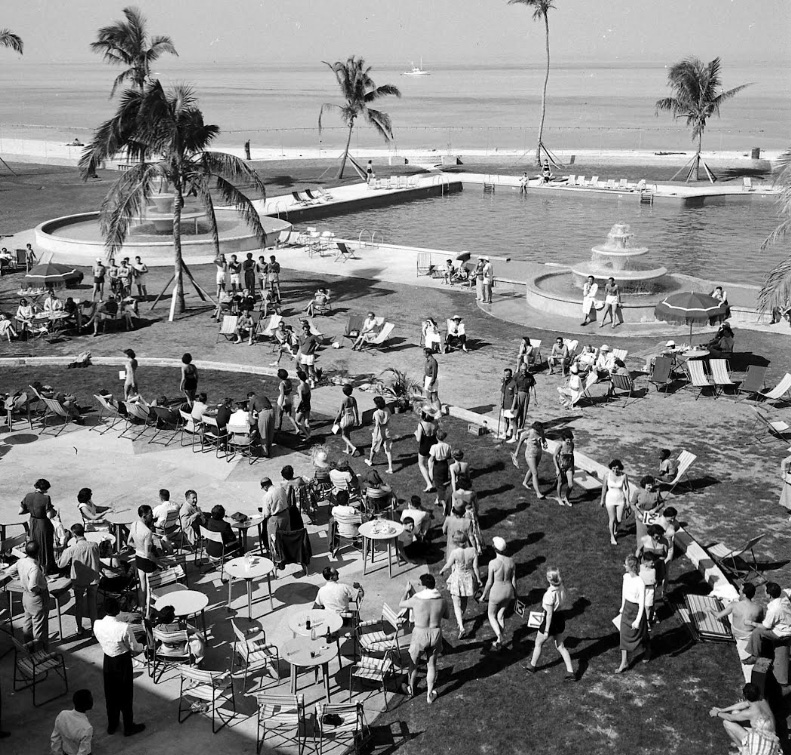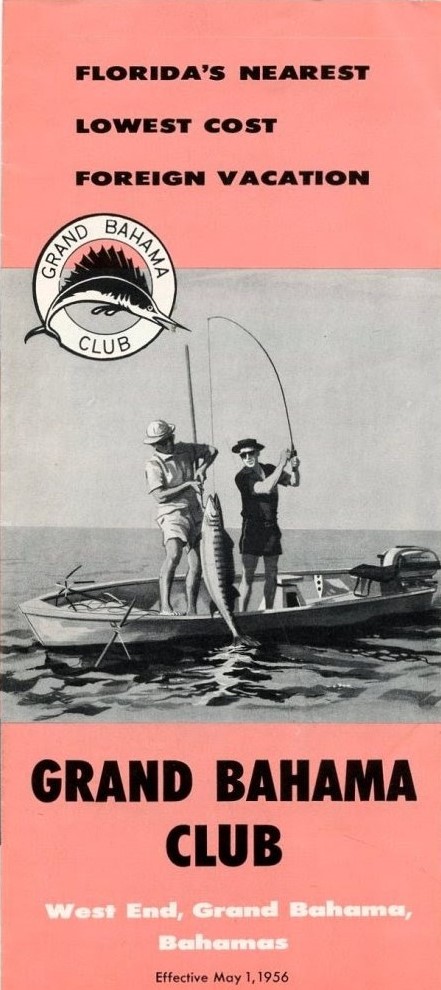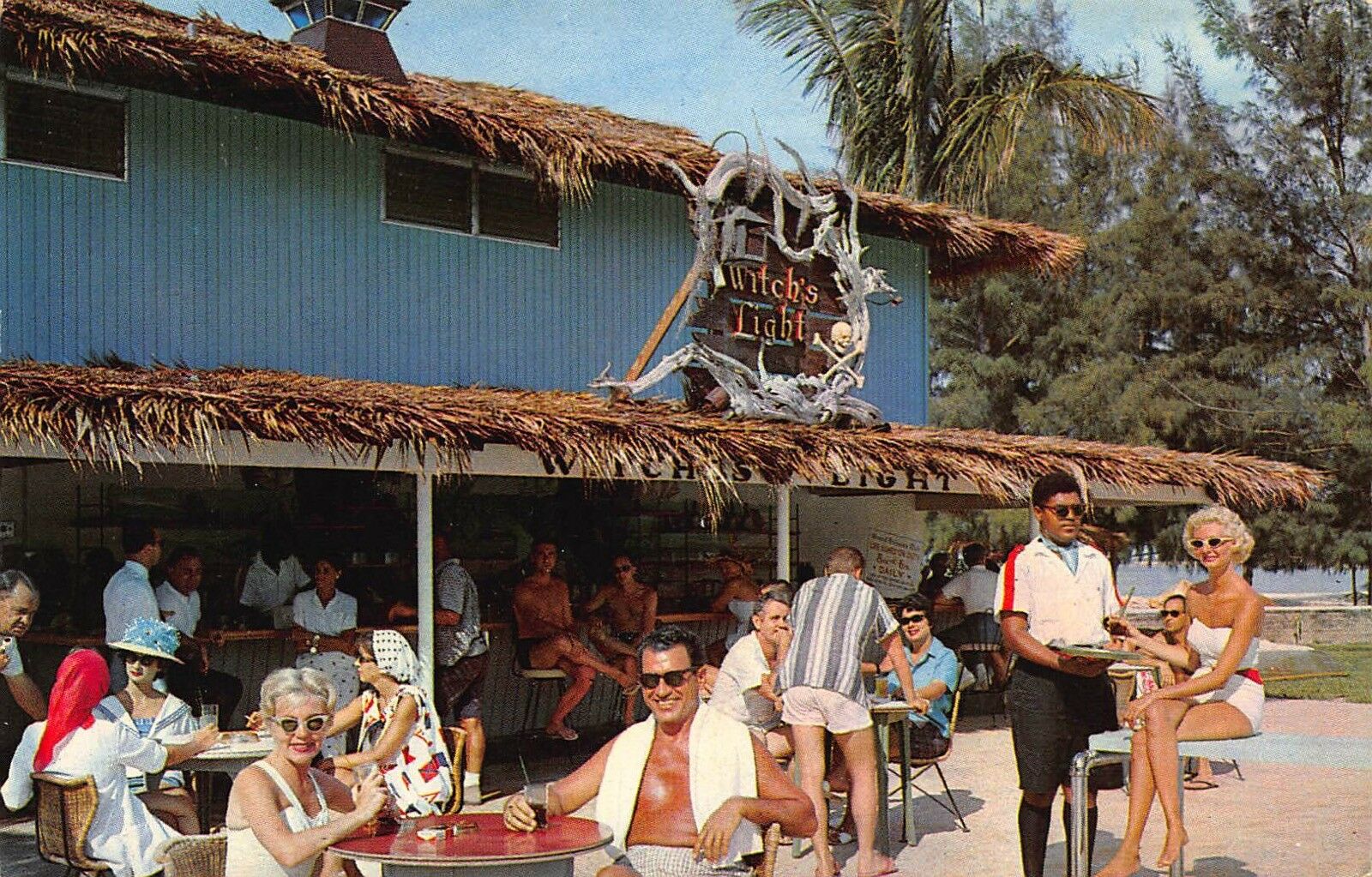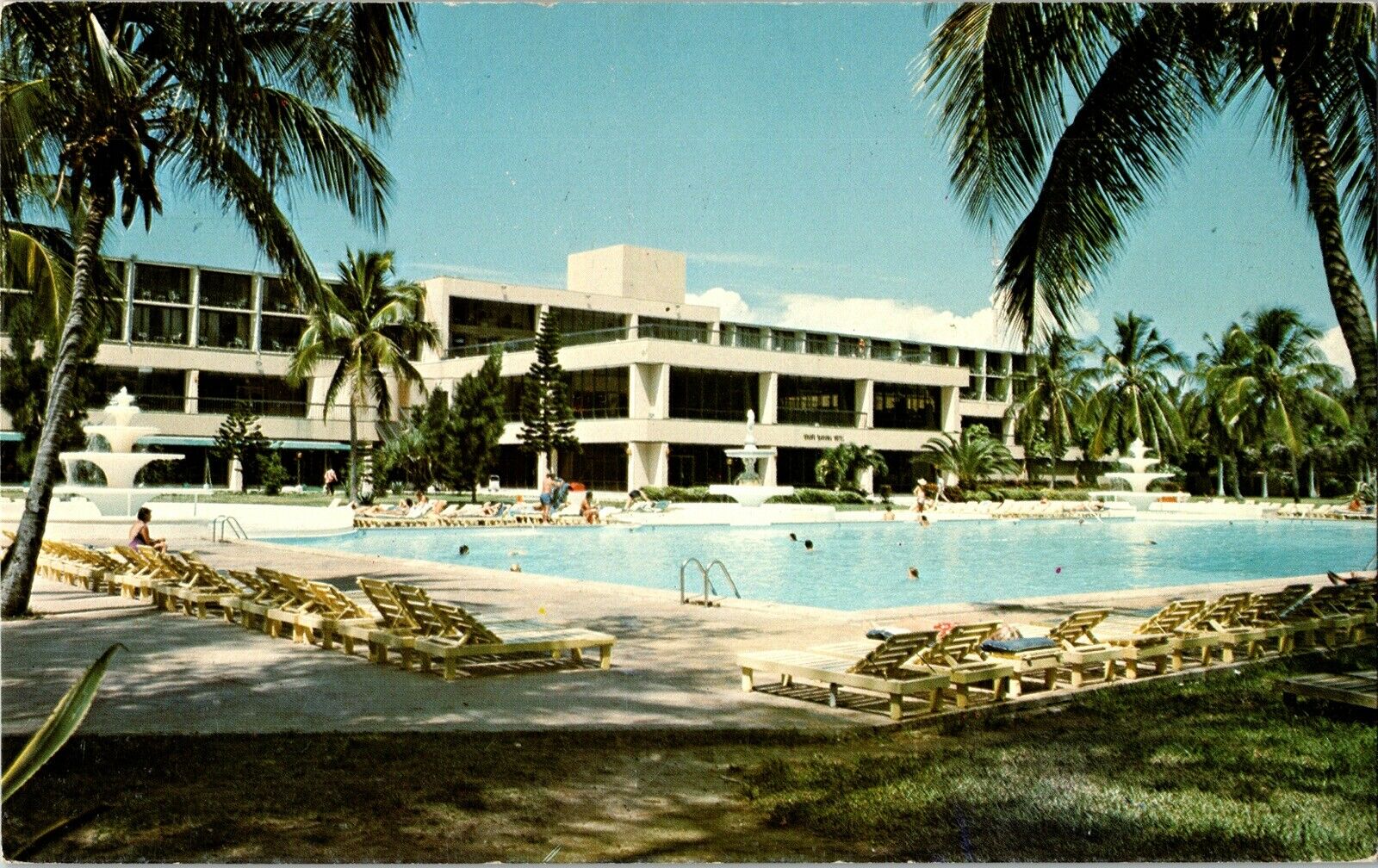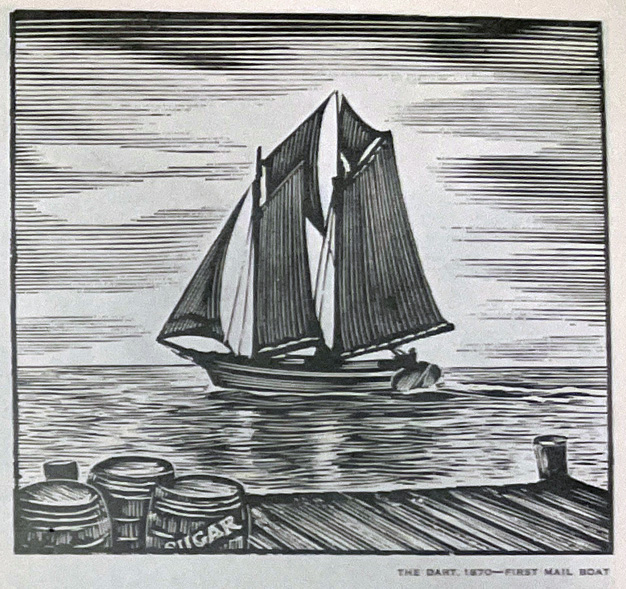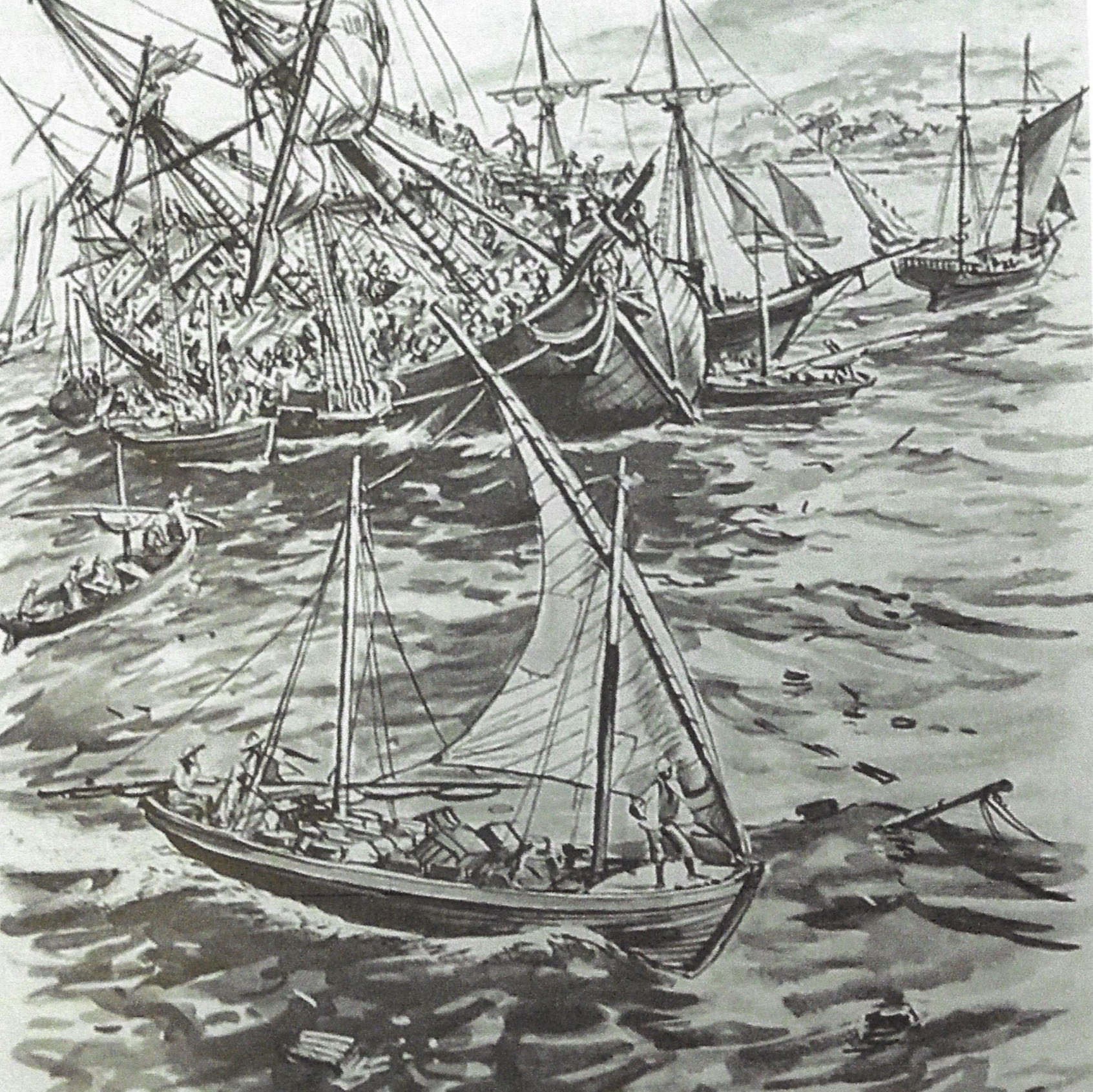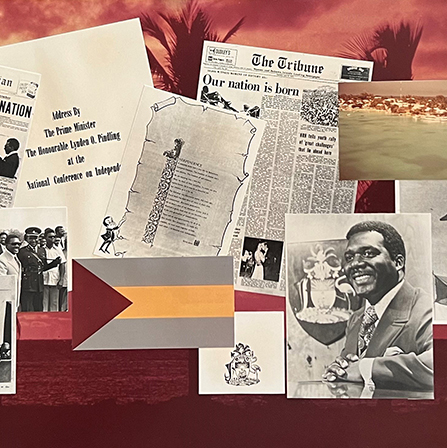History
Butlin's West End Debacle
In late 1947, Britain’s holiday camp king Billy Butlin arrived at West End, Grand Bahama aboard a Grumman Goose flying boat in search of a site on which to build a self-contained luxury resort. With the growing popularity of air travel and the proximity to the US, Butlin believed the crystal-clear sea and coral sands at the western tip of Grand Bahama would be the perfect place for his venture. The £1,500,000 plan called for a 5,000-foot runway, accommodation for 2,000 guests, a selection of shops, bars, restaurants, and the largest swimming pool ever to be built in the region. Within months, Butlin’s (Bahamas) Ltd. was formed, 625 acres at West End acquired and over 500 Bahamians recruited for construction. Although the partially completed Vacation Village opened in January 1950, Butlin’s Caribbean dream was already turning into a nightmare. The venture closed after just one season, leaving Butlin nursing heavy losses and fighting to maintain control of his holiday empire. How did it go so terribly wrong?
Billy Butlin was synonymous with seaside holiday camps in the UK, catering to over 1 million guests during peak summer seasons. From modest beginnings and with little education, he rose in stature to become Sir Billy Butlin MBE and an institution in Great Britain.
William Heygate Edmund Colborne Butlin was born in Cape Town, South Africa on September 29th, 1899 to parents from opposite ends of the social spectrum. His mother, Bertha Hill was the daughter of a baker, a profession he later gave up to become a showman travelling the fairs of Gloucestershire and Somerset. Butlin's father, also William, came from a more distinguished family of bankers who frowned upon the marriage, paying him a remittance to go abroad with his sixteen-year-old wife and never darken the family conscience again.
A marriage of such contrasts was not destined to survive the social climate of the time. When Butlin was six, his mother left husband William and returned to her family in England to work the fairs, with young Butlin in tow.
Within a few years, Butlin’s mother remarried and emigrated to Canada to start a new life. Unhappiness at school and the need for money at home prompted Butlin to end his formal education at age twelve. He became a messenger boy at Toronto’s largest department store Eaton’s, where his mother was already working. Showing some aptitude for drawing and painting, Butlin studied by night to become a commercial artist and soon transferred to the advertising department. It was while at Eaton’s that Butlin discovered Shadow Lake, the company’s holiday camp on 225 acres of rolling woodlands north of Toronto, complete with lakes, a farm, nine-hole golf course, tennis courts, library and seven log cabins accommodating up to 100 campers for an all-inclusive fee of $5 per week.
Still only fifteen but claiming to be seventeen, Butlin joined the Canadian Army at the outbreak of the First World War. He served as a stretcher-bearer on the battlefields of the Western Front, collecting the wounded and burying the dead. At the end of the war, he returned to Canada and to the advertising department at Eaton’s but failed to settle. Hankering for the life he had loved travelling the West County fairs in his youth, Billy rented a stall at the fair adjoining the 1920 Canadian National Exhibition during his summer holidays from Eaton’s. Spurred on by the success of his venture, Billy quit his job at Eaton’s and returned to his fairground relations in England.
A single hoop-la stall turned into several, proudly sporting the Butlin’s name and a distinctive red and white colour scheme. When the weekend crowds gravitated from local fairs to seaside towns, Butlin followed them. He opened his first permanent amusement park in Skegness on the Lincolnshire coast in 1927. Within a few years of expansion, he was employing up to 100 weekend staff in Skegness and soon replicated the success across a string of coastal towns.
Inspired by Eaton’s holiday camp near Toronto, Butlin opened his first holiday camp in Skegness on Easter Sunday, 1936. Unlike the other holiday camps in the UK at the time, Butlin’s boasted chalets with electricity and running water, dining and recreation halls, a swimming pool, and a boating lake. In the landscaped grounds were tennis courts, bowling and putting greens and cricket pitches. A second holiday camp in Clacton-on-Sea, east of London followed in 1938, the same year in which Parliament passed legislation giving a week’s paid holiday per year to all industrial workers. Not one to miss a promotional opportunity, Butlin soon ran an advertising campaign with the slogan: ‘Holidays with pay: Holidays with play: A week’s holiday for a week’s wage.’ Visitors to his two camps doubled from 50,000 in 1938 to 100,000 in 1939.
On the morning of September 3rd, 1939, UK Prime Minister Neville Chamberlain announced that Great Britain was at war with Germany. Almost immediately, the Skegness camp was taken over by the Royal Navy to train new recruits. It was ominously rechristened HMS Royal Arthur after a cruiser built in 1889 and sunk with all hands. The newly opened Clacton camp was commandeered by the Army, initially to be a prisoner-of-war camp but eventually became a training centre for the Royal Pioneer Corps. Butlin was paid 25% of the previous year’s profits as compensation.
The holiday camps were so well suited to military training that Butlin was commissioned by the War Minister, Hore-Belisha to complete construction of an already planned third camp in Filey, and to build brand new camps in Pwllheli, Wales and Ayr, Scotland. Butlin duly obliged on the proviso that after the war he could buy back the camps for three-fifths of what they cost the Government to build. In the years following the war, Butlin regained control of the camps and welcomed record numbers of servicemen and war workers seeking a well-earned holiday.
Britain emerged from World War Two victorious but bankrupt and with little prospect of bridging its balance-of-payments deficits for years to come. As John Maynard Keynes, the chief economic advisor to the new Labour Government soberly noted, the entire British war effort had only been made possible by American subsidies under the Lend-Lease programme, designed to help Britain but keep the US out of the war. When the fighting stopped, so did the funding. Facing a ‘financial Dunkirk,’ Keynes travelled to Washington seeking a $5 billion ‘gift’ in recognition of Britain’s heroic war efforts but had to settle for a $3.75 billion loan at 2 percent interest. A massive balance of payments deficit meant that Britain needed to severely restrict outflows of US dollars from reserves and to boost inflows.
Bahamas Beginnings
It was against the economic backdrop that Butlin commenced his overseas expansion, spending £1 million in 1947 purchasing and upgrading the Fort Montagu Beach Hotel in Nassau followed by the Princess Hotel in Bermuda. Butlin kept his Bahamas hotel open year-round and chartered planes to fly in guests from the US, bringing a welcome dollar tribute to the Crown colony.
A chance introduction to Brigadier-General Alfred Cecil Critchley holidaying in Bermuda was the genesis of Butlin’s Grand Bahama adventure, and near downfall.
Like Butlin, Critchley spent his formative years between Canada and Great Britain. He similarly joined the Canadian Army and fought on the Western Front, where he was wounded. While recovering back in the UK, Critchley established the Canadian Officers Training School at Bexhill in 1917. The school became a model facility and Critchley was soon recruited by the Royal Air Force to take command of their cadet program. By September 1918, Critchley was a 28-year-old Brigadier-General.
Between the wars, Critchley introduced greyhound racing to Britain. He opened his first track at Belle Vue, Manchester in 1926 and soon attracted crowds of almost 10,000 to each race meeting. The following year he signed a ninety-year lease of the disused White City stadium in London. Crowds of up to 40,000 flocked to the venue, attracted by the novelty and the excitement of on-track betting. With the house taking a fixed fee on all bets wagered, Critchley was on to a winner in every race.
By day, Critchley’s passion was golf. As a scratch handicapper he won national amateur tournaments in England, France, Belgium, and the Netherlands, leading to an invitation from Bob Jones to play the first ever Masters’ Tournament at Augusta, Georgia in March 1934. Away from tournament crowds, Critchley was known to play for pleasure against the then prince Edward, who subsequently became king Edward VIII upon the death of his father George V in 1936. Abdicating the throne after just one year, the now duke of Windsor was appointed governor of the Bahamas at the outbreak of World War Two.
It was at this time that the Air Ministry again turned to Critchley to take charge of RAF aircrew training. He oversaw operations until 1943 when he was asked by the Government to take over the running of the British Overseas Aircraft Corporation (BOAC), which also involved the planning of a new airport for London at Heathrow.
Disagreements with the Labour Government on the commercial direction of the state-owned airline saw Critchley depart BOAC in 1946 to become Chairman of privately-owned Skyways, backed by one of the most powerful financiers in the City of London, Harold Drayton. The charter airline’s core business was carrying oil industry personnel and freight between the UK and the oil fields of the Middle East. 1947 saw Skyways expand into the burgeoning package holiday market, running ‘aerial cruises’ to Switzerland and the Canary Islands for travel pioneer Sir Henry Lunn Ltd.
It was the winter of the same year that Butlin met Critchley socially in Bermuda and concocted the plan. Butlin would build a luxury vacation village; Critchley would provide an air service; Drayton would be tapped for investment capital. All they needed now was a site, and Critchley’s pal in Nassau, real estate developer Frank Holmes Christie, knew just the place.
West End Site
Although a reluctant governor of what he considered to be a “third-class British colony,” the duke of Windsor had genuine concern for the welfare of Bahamians. During his tenure as Governor, he was particularly focused on creating employment opportunities for Black Bahamians, so long denied by the rich and mainly white merchants of Bay Street who wielded absolute political power. One such initiative was a formal agreement with the Eisenhower administration to permit the entry of up to 5,000 Bahamians as seasonal farm workers to the southern states, filling labour shortages caused by Americans serving in the armed forces or working in the more profitable war industries.
When multi-millionaire Swedish industrialist Axel Wenner-Gren proposed a crawfish canning plant offering much needed employment at West End, Grand Bahama, the Duke naturally gave it his full support and even paid a personal visit aboard Wenner-Gren’s luxurious steam-powered Southern Cross yacht.
Wenner-Gren was regarded with deep distrust in the corridors of Whitehall and Washington, however. When Winston Churchill learnt of the voyage, he sent a cable to the duke admonishing him not to sail aboard the yacht again. Referring to Wenner-Gren, the prime minister declared, “This gentleman is, according to reports I have received, regarded as a pro-German international financier, with strong leanings toward appeasement and suspected of being in communications with the enemy.”
In January 1942, Wenner-Gren was placed on an economic blacklist by the United States. Mounting political pressure forced the duke to seize Wenner-Gren’s Bahamian assets, including the canning plant and over 625 acres of West End land ear-marked for agricultural development. The business was taken over by General Foods of Boston but traded at a loss until 1946, when it finally closed.
Planning
The coastal tract was perfect for the expected half-mile square footprint of the Vacation Village and offered sufficient space for a nearby aerodrome. Butlin’s initial requests to purchase the land were curiously rebuffed. It transpired that the US Air Force was simultaneously scouting the island for a location on which to build a ballistic missile tracking station. When the US picked the more centrally located Gold Rock Creek, Butlin was permitted to acquire the desired West End land from Wenner-Gren interests for £1 an acre.
Butlin’s (Bahamas) Limited was incorporated on April 13th, 1948 with initial funding of £200,000 from Butlin personally, £100,000 from Critchley, £100,000 from Butlin’s Limited of England and £100,000 from Drayton’s Cape & General Finance Company. Drayton underwrote a further £600,000 investment subject to successful negotiations with the Bahamian government.
Next, Butlin bolstered his team by installing Colonial Office insider and former Governor of the Bahamas, Sir Bede Clifford as Chairman and local Bay Street power-broker Stafford Sand as attorney. With no conflict-of-interest laws to restrain him, the omni-potent Sands was simultaneously the legal advisor to the Bahamian government, an elected member of the Legislative Branch and a private attorney-for-hire.
Meanwhile, the tried and tested teams behind Butlin’s UK holiday camps were busy drafting plans. Architects Lionel H. Fewster & Partners of London designed the Vacation Village. Chartered quantity surveyor Alfred J. Clarke of Pwllheli translated the drawings into a bill of materials amounting to £592,000. Labour and essential infrastructure like water, sewerage, roads, and runways would bring the anticipated investment to £1,000,000.
To minimise dollar expenditure, materials and equipment would be acquired in England where possible, shipped from Liverpool docks to Nassau and then conveyed to the shores of West End on tank landing craft. An exception would be timber which could be supplied locally from the Pine Ridge lumber operation, then being modernised by new owner Wallace Groves.
Negotiations
On May 28th, 1948, Stafford Sands formally presented Butlin’s plans for a luxury vacation village and aerodrome at West End to the Colonial Secretary in Nassau, contingent on eight pages of concessions to be made by the Government, Treasury and Crown. Butlin and Critchley were invited to discuss their plans with Governor William Murphy and his Executive Council on June 24th and again on June 28th. On both occasions they were supported by their attorney Stafford Sands. As was the Government.
The plan called for accommodation for 1,000 guests by January 1st, 1950, increasing to 2,000 within two years and offering “all amenities such as swimming, fishing, boating, dancing, concerts, table tennis, theatrical shows, cinemas, bowls, tennis, billiards, golf and special star events and other sports according to the requirements of the clientele”. The all-inclusive rate would be between $80 and $100 per week with guests likely to spend a further $20 for the purchase of cigarettes, beverages, and items from the village stores. Gross takings were expected to be in excess of $4,000,000 for the annual 6-month season, with a further $2,000,000 accruing from the air service.
Before the dollar tap could be turned-on, however, a series of concessions were requested from the Government. These included the importation of all necessary building materials, furnishing and equipment free of taxes; the waiving of landing fees for weekend visitors and a 10-year exemption on taxation of any kind being levied on the earnings of the Company. Butlin also sought a lease on nearby Indian Cay to prevent ventures competing with the Vacation Village and the option to purchase an additional 20,000 acres at a price of £1 per acre at any time during 15 years from the date of the agreement, for future expansion and property development. These requests were all granted with only minor amendments.
Deeper within the list, however, were two demands which Governor Murphy suspected Critchley was behind. The first was to allow a totaliser for horse, dog, and other racing from which 5% would accrue to the Government and 10% to the Company. The second was “to issue a certificate of exemption under Section 255 of the Penal Code so as to enable the company to operate slot machines, pin ball machines, and, if the company desires, other games of chance or mixed chance and skill without being subject to criminal prosecution.” In other words, a casino.
Gambling had been illegal in the Bahamas since 1901, but a seasonal casino had operated in The Bahamian Club on West Bay Street, Nassau since 1920 and another on Cat Cay, south of Bimini. Both were made legal in 1939 through an act sponsored by Stafford Sands that allowed the Bahamian Governor in Council to grant exemptions to the law. While Butlin’s (Bahamas) Ltd. would be permitted to operate a totaliser for races and a few slot machines, a full-blown casino was not entertained.
Even though some of Butlin’s demands “verged on the outrageous,” correspondence between Governor Murphy and his Colonial Office colleagues in London was favourable to the overall plan. Highlighting the Colony’s proximity to the US, one civil servant noted “If any tourist development is to be undertaken from a dollar earning point of view prima facie the Bahamas is of all parts of the Colonial Empire the one in which such development should be promoted. This is a simple question of geography.”
Another advised that “…the tourist trade is the Bahamas’ principal resource. Possible industries are few and agricultural development difficult. The climate and beaches can, if entertainment and accommodation are added, attract many thousands of visitors to the great increase of the territory’s income.”
If tourism was the best hope for the Bahamian economy, the Colonial Office believed Butlin was the man to make it happen. “The Butlin project seems likely to develop just the kind of resort to which Americans have grown accustomed. What I hear of the Butlin camps in Great Britain suggests that Mr. Butlin knows his business down to the last detail and would undoubtably provide what the customers wanted.”
Agreement
Ten days after meeting Butlin and Critchley with his Executive Council, Governor Murphy recommended that the Legislature give “earnest and favourable consideration” to ratifying the revised agreement and to “the enactment of such legislation as may be necessary to give effect to the terms and conditions of the agreement.” Murphy also delayed proroguing parliament until the House of Assembly and subsequently the Legislative Council completed their work. On August 17th, 1948, the Butlin Vacation Village (Grand Bahama) Act 1948 assented, authorising the Governor to enter into the agreement with Butlin’s (Bahamas) Limited.
With the legislative path cleared, Governor Murphy duly signed the agreement with Butlin’s (Bahamas) Limited on behalf of the Government. This was in turn a trigger to raise additional finance for the construction phase. Drayton arranged a public offering of £600,000 cumulative preference shares paying a 5% dividend. These were duly snapped-up in the London market, even though better suited to a stable rather than speculative venture of this kind. Drayton and Butlin also ploughed another £300,000 into the venture through ordinary shares, which offered better upside should the Vacation Village succeed.
Delays
Due to delays gaining passage, an advance team of 30 European engineers did not arrive at West End until late November 1948, setting-up camp between the Wenner-Gren canning factory and the local Star Hotel, owned by the Grant family. Their first task was land clearance, survey work and the construction of timber living quarters for the balance of the construction staff to follow. The diesel-driven generators at the plant were overhauled and supplemented to supply electricity for the project.
The quantity surveyor Alfred J. Clarke was enlisted to supervise construction and established offices at Nassau and West End for this purpose. The main contractors for the construction work would be long-time Butlin partners Reed & Mallick of Salisbury, England; sub-contractors for plumbing, mechanical and electrical installations A. F. Snelling & Company of Hull, England; and S. C. Alden for masonry and plastering work.
Although the original layout and designs for the Vacation Village were prepared by architects Lionel H. Fewster & Partners in London, Carlos B. Schoeppl of Miami subsequently took over the preparation of architectural details. Schoeppl had designed the palatial Sigrist House on Prospect Ridge in Nassau for the millionaire aviation pioneer Fredrick Sigrist and was subsequently picked by the Government to design the new Bahamas General Hospital, later christened Princess Margaret Hospital.
The supply of construction materials became a major problem due to dock strikes in England. When deliveries did eventually arrive, they came in such a rush that the wharves at Nassau became choked with Butlin’s supplies. As one worker put it, "if you wanted a toilet roll, it was buried under a hundred tons of steel."
Although much of the plant and machinery for the construction phase was obtained from England, Plato Cox of Auto-Marine Engineers Inc., Miami supplied seven Caterpillar industrial tractors with bull dozers or scraper attachments, four bucket type excavators, three trench excavators, four large dumpers, thirty-two trucks, ten concrete mixers and a stone crushing and screening plant.
Water supplies were pumped from boreholes spread over the site and a 250,000-gallon reservoir constructed. The foul drainage system for the village was also installed, with the sewage falling by gravity to a swamp at the southwest corner of the site and pumped to a sea outfall on the west shore.
Approximately two miles of roads were also constructed within the Vacation Village site and onwards to the airport, where a 5000-foot runway complete with a parking apron and a sea ramp for amphibian aircraft was underway. Levelling the rock for the airstrip proved more challenging than expected. Eventually a 15-ton rock plough was designed by Mr. Reed for the purpose, delaying construction until June 1949. A new radio transmitting station and control tower were also built and equipped.
The residential accommodation took the form of two-storey pastel coloured chalet blocks. The first block contained 44 double suites but a design change for subsequent blocks increased the count to 64. Reed & Mallick intended to utilise their patented but experimental ‘Reema’ pre-cast concrete construction method, designed for efficient house building in post-war Britain. The Reema system involved the offsite fabrication of reinforced concrete panels for quicker assembly on-site. The building of the fabrication facility and the extensive testing of locally quarried stone aggregate and beach sand meant that production of concrete panels did not commence until July 1949 and on-site construction not until September. In the meantime, five chalet blocks were traditionally built with bricks made from locally sourced materials. Four blocks would be for guests and one for administrative staff. Construction of the main buildings, comprising a central kitchen, two dining rooms, four lounges, four bars, swimming pool and gardens also commenced in June 1949.
Midet Aviation of West Palm Beach were contracted to operate a minimum of two flights per week, ferrying staff and supplies to West End aboard their 8-seater Grumman Goose flying boat. From May 31, 1948 to May 31, 1950, Midet operated 227 flights to West End. This was in addition to a steady business flying between West Palm Beach and Walker’s Cay, 50 miles northeast of West End, where Florida businessman Buzz Shonnard ran a small hotel, airstrip, and marina for sports fishermen.
Within a few months, the labour force at the Vacation Village construction site peaked at 165 Europeans and 1050 Bahamians, drawn mainly from other Out Islands. Frustrated by the slow pace of progress, however, Butlin appealed to the Bahamian foreman to get his men to work a little harder. “Boss,” he said with a laugh, “you'll get like us long before we get like you.”
Dock strikes and a work-shy labour force were not the worst of Butlin’s woes, however. On August 26th, a hurricane struck the Bahamas, bringing local shipping to a halt. On September 19th, sterling was devalued, causing the cost of US supplies to the Vacation Village to increase by 30% overnight. Despite only raising additional finance in November, funds were depleted again by year-end. Drayton provided emergency loans totalling £450,000 from his investment trusts in January 1950. This cash injection gave Drayton a controlling stake which he used to remove Sir Bede Clifford as Chairman of Butlin’s (Bahamas) Ltd. Critchley’s number two at Skyways, Brigadier Keith Thorburn was installed in his place and dispatched to Grand Bahama to take control.
Mindful that the concessions granted by the Bahamian Government were contingent on a January opening and that operating income to pay the first dividend to cumulative preference shareholders would soon fall due, the doors of the half-finished Vacation Village swung open on January 28th, 1950.
To drum up interest, Butlin arranged a ‘Mystery Flight’ with Capital Airways. Forty guests from Philadelphia paid $129 each for an all-inclusive weekend at an unknown location in the Caribbean. Ever the publicist, Butlin had LIFE staff photographer Alfred Eisenstaedt capture their every step for the magazine.
Too Little Too Soon
The press gave a cautious welcome to the Vacation Village. One noted that the perfect setting boasted “incredibly blue waters and impossibly golden sand” but that the rooms were “squarish cells with the appearance of dollar-saving at the expense of beauty.” Another flagged that Butlin’s promotion had outpaced delivery with many of the amenities still only on the drawing board. “Exactly when it will measure up to what the early brochures describe is anybody’s guess, for there is much construction to be done. Some of this unfinished construction involves facilities the brochures already boast about.”
Despite this lukewarm reception, the Vacation Village welcomed 17,000 guests in the first season. No passport was required for travel and vacationers were permitted to return with up to $200 worth of goods duty-free. Daily flights on a 21-seater DC-3 were now available from nearby West Palm Beach via Midet Aviation, to whom the Civil Aeronautics Board granted exclusive rights to the direct route. Carriers with existing routes between Nassau and Florida, such as Mackay Airlines and BOAC subsidiary Bahamas Airways, added West End stops to their schedules. Contract carrier Resort Airlines was signed-up by Butlins to fly all-inclusive guests from north-eastern and mid-western states as well as from Miami and West Palm Beach. Resort Airlines also flew Butlin’s staff in and out of the Vacation Village, along with 53,000 lbs of cargo in the first season, mainly consisting of perishable produce, milk, eggs, and other essential food items.
Flights from West Palm Beach ranged from $10-$13 each way. Vacation Village rates were $15 per day or $98 per week. Prices dropped to $12 per day and $79 per week from mid-April. Average monthly receipts in the first season totalled only $100,000, falling well short of the projected take of $4,000,000 for the first year and nowhere near enough to fund the completion of the Vacation Village.
Back in England, Drayton appealed to the recently established Colonial Development Corporation (C.D.C) for the desperately needed funding. His not unreasonable argument was that Butlin’s (Bahamas) Ltd. had delivered essential infrastructure in West End, including an airport built to Ministry of Civil Aviation specifications, whereas hotels in Nassau enjoyed equivalent services courtesy of the Government.
Minutes of C.D.C. Board meeting held on June 2nd, 1950 show that the request was unanimously rejected. Their sobering judgement was that “even if the capital already sunk into the project were completely written off, it was doubtful whether the new capital required to complete the project could earn a commercial return.” Treasury official Sir Wilfred Eady was similarly pessimistic about official support, saying that the Treasury “would not be disposed to urge unorthodox action on the ground of dollar earning potential of the project, the extent of which was somewhat doubtful.”
With no prospect of a UK government rescue, Drayton dispatched Brigadier Thorburn and Butlin on a capital raising mission to the U.S. Three separate groups had expressed interest in purchasing the Vacation Village as a going concern. Each was scheduled to meet the promoters in West End but the outbreak of the Korean War in late June changed the outlook of US investors. Only one group showed-up but declined to make an offer. The Vacation Village closed for the season on September 6th.
Liquidation Threat
A week later it fell to Brigadier Thorburn to tell a meeting of shareholders in London that not only would there be no dividend, “the company would go into liquidation within two weeks unless additional funding of £800,000 was found”.
Commenting on how things came to this, he stated: "First, I don't think that in the original estimate people had really taken into consideration the very great difficulty of building a camp on what was virtually a desert island. All the material had to be landed in tank landing craft. If you forgot anything you had to send an aeroplane to fetch it. It was not a matter of going down to the village shop and buying a bag of nuts."
He went on to explain that the airfield had cost more than expected and sterling devaluation had added to the cost. The dock strike in England had thrown out the arrival sequence of materials, many of which had to then be bought in the U.S. at greater cost.
Reflecting on what had been an up-hill battle from the outset, he stated "Ever since I became Chairman, we have always been in effect broke. We have never been able to pay our creditors. It is a very unfortunate position.”
The mounting crisis almost culminated in the winding-up of the company on the very day of the shareholder meeting, but for a technicality. A petition that morning by Quaker Oats of Southall, Middlesex to put the company into liquidation over an outstanding debt of £144 was deemed to be outside the jurisdiction of UK courts on the basis that Butlin’s (Bahamas) Ltd. had no local assets.
There would be no such escape for the company in the Bahamas, however. Within days, 17 writs had been filed in Nassau for a total of £606,000. The largest was from Drayton’s own Cape & General Finance Ltd. for £462,856. A court hearing was set for October 18th.
Gambling Syndicates Circle
Before the winding-up order could be heard, gambling syndicates started to take an interest in the Vacation Village.
First to make a move was Raymond Craig who, according to the Miami Herald, “operated large gambling establishments unmolested in Miami.” Such were his political connections that Craig brazenly attempted to push a bill through the Florida Legislature to legalise the handling of off-track bets by bookies in 1949.
In January 1950, the Senate Special Committee to Investigate Organised Crime, popularly known as the Kefauver Committee, started to shine a light on the extensive scale of gambling in the US and its control by unsavoury associates of men in high office.
Now under indictment by a Florida grand jury for allegedly running several gambling houses near Miami, Craig flew to Nassau to strike a deal with Stafford Sands and Frank Christie. He was later given a tour of the Vacation Village by Butlin himself.
While the prospect of running a legalised gambling operation a mere 70 miles from the Florida coast no doubt appealed to Craig, local church leaders were emphatically opposed. The Bahamas Christian Council, composed of ministers and laymen of the various denominations, expressed concern over "persistent rumours" that the Vacation Village would be turned into a casino. The churches' resolution recorded an "emphatic protest against such a move.” It called on "all Christian people in the colony to resist by all constitutional means any further development in this direction".
With such vehement opposition, Craig was quickly rebuffed. Commenting to the Daily Express in February 1951, Stafford Sands stated that "once his identity as a gambler was discovered, his attempted negotiations were immediately discouraged."
A more formal £1,450,000 offer from Lionel Marks, President of Ajax Corporation of Indiana was subsequently made on behalf of a "mystery group" of Americans who Stafford Sands assured "are most honourable men and unconnected with gambling".
In early March 1951, Major General Robert R. Neville, Governor of the Bahamas, along with 24 senior officials and legislators flew to Grand Bahama to meet Mr. Marks. His syndicate’s plans included the building of a 256-room hotel, 44 cottages, an 18-hole golf course with club house, a yacht club, and a racecourse.
Marks had a clear longer-term vision for the Vacation Village, noting that "in most Caribbean resorts the governments have seen fit to legalise gambling as an attraction to tourists. In the Bahamas gambling on a small scale is permitted. It is felt that the new resort on Grand Bahama should not be subject to any greater restrictions than are now imposed elsewhere. However, I wish to make it clear that no formal application by my group is before the Bahamas Government at this time to permit gambling at the Vacation Village.”
With rumours circulating about well-known large-scale gamblers making up the syndicate fronted by Marks, the Bahamas Commissioner of Police made confidential enquiries with then FBI director J. Edgar Hoover as to the financial standing, reputation, and affiliations of Mr. Lionel Marks.
On April 9th, Hoover gave Marks a clean bill of health. Embarrassingly for the FBI, an exposé in the Washington Post later the same month linked Lionel Marks to crime boss and racketeer Frank Costello.
The Marks deal duly collapsed but on April 18th, the Financial Times reported an £805,000 offer from William Dunn of Merchants Distilling Corporation of Terre Haute, Indiana. What wasn’t reported however was that Dunn was also Chairman of Ajax Corporation and so was party to the original Marks bid.
The connections between Dunn and Marks were clearly known to Butlin, as the three were named as directors of Grand Bahama Co. Ltd. when registered on December 1st, 1952. The Vacation Village and its creditors remained in limbo throughout 1953 due to a series of court adjournments, prompted initially by the alleged ill health of Dunn and then due to apparent challenges raising the required funds.
A more likely reason for the failed investment in West End was the coup d'état staged 300 miles away in Cuba by Fulgencio Batista. The US-backed military dictator opened the doors of Havana to mob interests. Frank Costello associate and casino impresario Meyer Lansky was dispatched to manage the mob’s gambling investments. Jewel in the crown was the casino at the Hotel Nacional where Lansky installed his trusted lieutenants Max Courtney, Frank Ritter, and Charles Brudner to run operations. Batista’s Cuba proved a profitable playground for the mob but the potential of Grand Bahama was not forgotten. When the Batista regime was toppled by Fidel Castro and gambling venues shut down, who should appear as the general manager, credit manager and floor manager respectively of the Monte Carlo Casino at the Lucayan Beach Hotel, only Messrs Courtney, Ritter, and Brudner – but that’s another story.
So with no prospect of new investment and after more than three years since the order was first sought, Chief Justice Guy Henderson finally put Butlins (Bahamas) Ltd. into liquidation on Dec 7th, 1953. Mr. R.T. Symonette of Nassau and F.B. Proctor of London were appointed joint liquidators. Harald Drayton’s Cape & General Finance Company, representing about 60% of creditors, purchased the assets of the company for $390,000 under the name of Grand Bahama Properties Ltd.
To keep the valuable government concessions alive and to have any hope salvaging its investment, Cape & General was obliged to maintain a functioning resort. A scaled-back plan saw Midet Aviation lease a single chalet block from Grand Bahama Properties Ltd. After minimal refurbishment Midet launched the more modest 64-room Grand Bahama Club in early 1955 with a 3-day/2-night travel and accommodation package for $23.50.
The Grand Bahama Club proved popular with the anglers Midet was already flying to nearby Walker Cay. The pristine waters adjacent to the club teemed with game fish of every description. Sailfish, kingfish, tuna, marlin, and wahoo in the deep; grouper, snapper and barracuda around the reefs and the world’s finest bone fishing in the shallow waters offshore. Twin outboard motor skiffs accommodating 4 people could be rented for $15 per half day, including a local guide to take guests to the best fishing grounds.
Bolstered by the reprieve from the sport fishing market, Cape & General took the Grand Bahama Club into direct control for the 1956 season. To coincide, Bahamas Airways stepped up their service with daily flights from both Miami and West Palm Beach and four weekly services from Nassau to West End. Over the next 2 years additional chalet blocks were opened, bringing guest capacity up to 250 and a further 14 fully equipped fishing boats were added to the fleet. James Nuthall, Director of the operating company made no pretences about the resort when speaking to the Miami Herald, however. “We aren’t offering luxury and we can’t compete with Miami Beach but visitors to the Grand Bahama Club will be able to relax in a natural setting, to enjoy a Bahamian way of life at prices far below the levels in Nassau.”
Jack Tar Hotels
With the resort finally operating as a going concern, Cape & General looked for a return on their investment by putting it up for sale in 1959. Holiday Inns of America inspected the resort and proposed a lease arrangement. Cape & General declined the offer, preferring an outright sale instead. This did not thwart Holiday Inn’s ambitions on the island, however, as they subsequently built their then largest ever hotel, comprising 614 rooms, further east on Lucayan beach.
A second suitor emerged in the form of the rapidly growing Jack Tar Hotels group of Galveston, Texas. Led by hotelier Ed Leach and backed by Texas financier Charles A. Sammons, Jack Tar Hotels committed to a $2,500,000 purchase and refurbishment in May 1959. The duo wasted no time. By December, a major expansion and renovation was complete with air conditioning, televisions and telephones added to all rooms. The official re-opening weekend in February 1960 was attended by over 400 guests including Stafford Sands, who was by then Chairman of the Bahamas Development Board and Sir Roland Symonette, leader of the House of Assembly.
Over the following two years, many amenities were added, including a 100-berth marina accommodating boats up to 125 feet in length and an 18-hole, 7,000-yard golf course designed by Florida golf architect Mark Mahannah. The M.V. Grand Bahama was commissioned to ferry guests and supplies from Miami to West End three times weekly. The Grand Bahama Club name was also upgraded to the more prestigious Grand Bahama Hotel & Country Club during this period.
A Vision Fulfilled
In 1962, Billy Butlin made a nostalgic return to Grand Bahama as a guest of Charles A. Sammons. What he found was a magnificent 416-room all-inclusive resort boasting the greatest variety of tourist facilities in the Bahamas, if not in the whole of the Caribbean. Butlin saw his vision fulfilled. As Peter Barratt notes in his definitive book on Grand Bahama, Billy Butlin envisaged the right development in the right place but was about ten years ahead of his time.
Main Sources:
- • Barratt, Peter J. 1972. Grand Bahama. Newton Abbot: David & Charles.
- • Butlin, Billy, and Peter Dacre. 1982. The Billy Butlin story: "a showman to the end". London: Robson Books.
- • Critchley, A. C. 1961. Critch!: the memoirs of Brigadier-General A.C. Critchley, C.M.G., C.B.E., D.S.O. London: Hutchinson.
- • Mystery Flight, LIFE Magazine, 27 May 1950
- • Butlin’s in the Bahamas, Picture Post, 17 June 1950
- • Butlin Vacation Village, Commissioner’s Report for Grand Bahama, 1949
- • Proposed Butlin Holiday Camp at Grand Bahama, Apr. 1948 Apr – Jan 1949, CO 23/874
- • Bahamas: Butlin's (proposed) airport, 1948-1949, CO 937/66/5 & 6
- • Butlins (Bahamas) Ltd. Confirmation of Supplementary Agreement Act, 1950. Financial difficulties, Jan. 1950 – Dec. 1950, CO 23/890
- • Butlins (Bahamas) Ltd., financial difficulties, Jan. 1951 – Sept. 1951, CO 23/891
- • Failure of Butlin's "Vacation Village" in the Bahamas, 1952-1953, CO 1031/976
